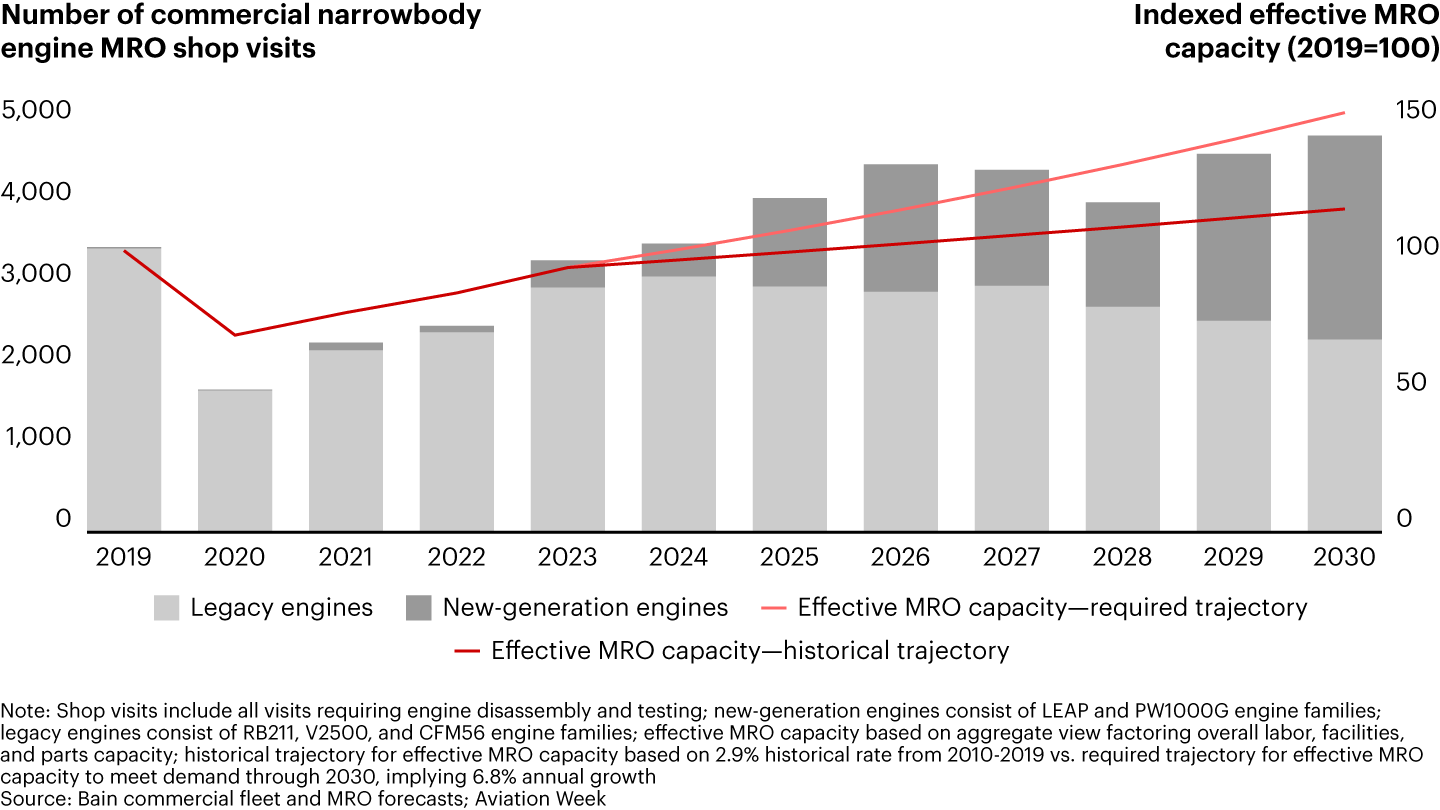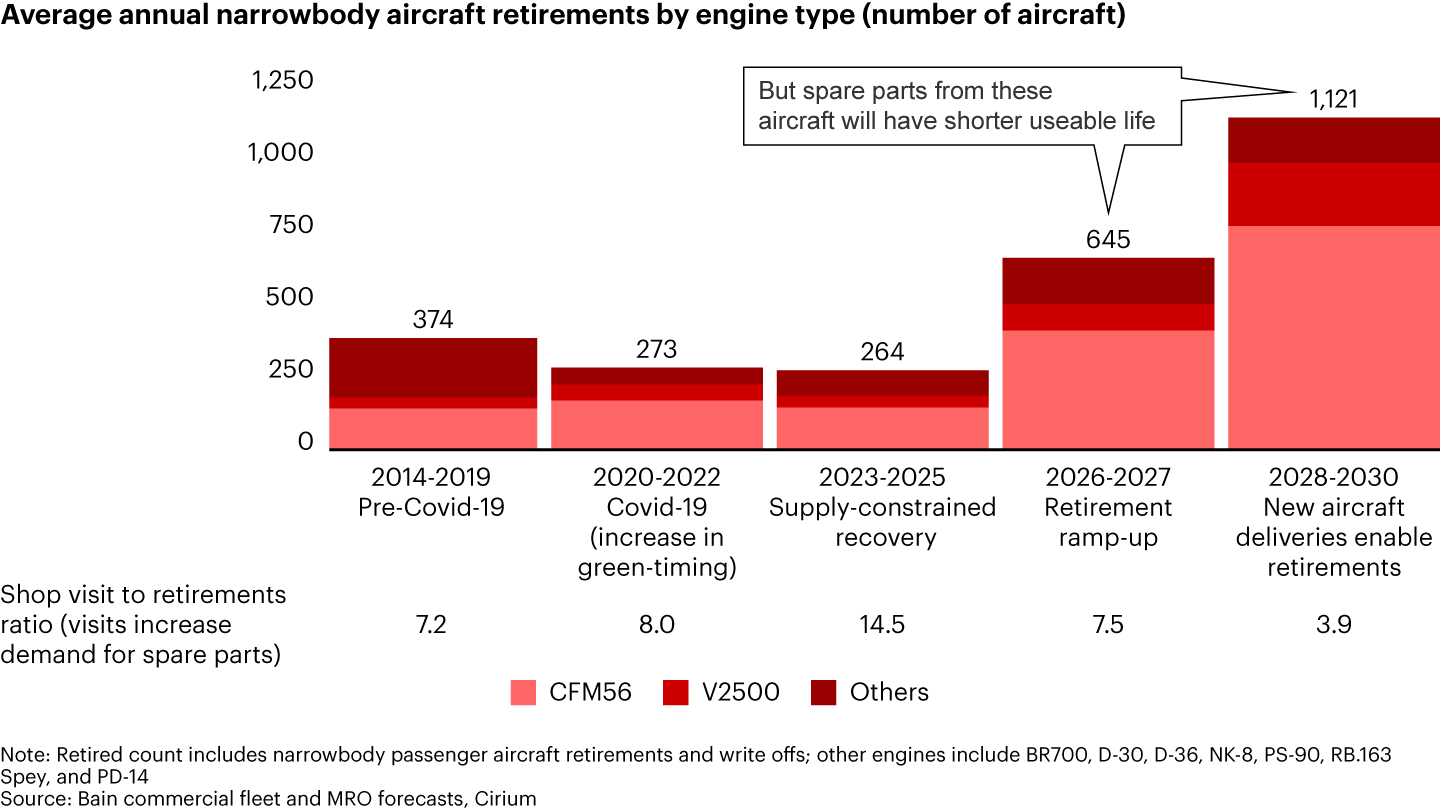Etude
 }
}
At a Glance
- Limited capacity for aircraft engine maintenance, repair, and overhaul threatens to constrain air travel growth.
- Shop turnaround times hit record highs, with peak delays adding up to two to four months to pre-pandemic levels.
- The demand for new parts from suppliers outpaces supply by 10% to 20%, and the availability of used parts remains severely constrained.
- The shift to new-generation aircraft creates an opportunity to invest in capacity and operational efficiency.
Aircraft engine maintenance, repair, and overhaul (MRO) has become a choke point for commercial aviation. Durability challenges with new-generation aircraft engines are adding to delays. Long maintenance intervals, which are particularly acute for narrowbody engines, threaten the continued recovery of post-pandemic travel.
MRO providers have struggled to service a growing number of aging narrowbody engines as airlines seek to extend their lives. Increasing the strain, new-generation engines are coming in for their first scheduled, or even premature, shop visits. The combined surge in demand has left airlines facing historically high shop turnaround times (TATs), which were up by 35% or more for legacy engines and more than 150% for new-generation engines, compared to pre-pandemic levels (see Figure 1). In addition, the wait times just to secure an MRO slot rose by two to three months and, in some cases, six months. These uncommonly long delays to maintain and repair engines have reduced the availability of airline fleets.


While the industry has made some headway in restoring parts, labor, and facility capacity that was cut at the outset of the pandemic in 2020, Bain analysis shows engine MRO demand is likely to experience a near-term peak in 2026 and remain constrained through the end of the decade. The capacity shortage presents a challenge but also an opportunity for MROs and suppliers. Companies that invest today will be best positioned to capture a larger slice of the market and propel long-term growth.
How did we get here?
A combination of factors has created a near-perfect storm for engine services. Shop visits deferred during the pandemic led to significant pent-up demand. At the same time, newer-generation CFM International LEAP engines and Pratt & Whitney GTF engines are requiring repairs in much greater numbers than anticipated due to an array of issues.
Compounding these delays, original equipment manufacturers (OEMs) have struggled to ramp up production of new-generation aircraft due to supply chain constraints and quality setbacks. Deferred deliveries mean airlines must continue to rely on aging fleets. Many of these engines would already have been scrapped for parts but instead are still in use and returning to MRO shops in growing numbers. And servicing aging engines often involves greater complexity and longer turnaround times.
A lack of spare parts is also contributing to longer shop visits. Demand for OEM parts is outpacing supply by 10% to 20%. Labor shortages are adding to maintenance delays, with MRO shops struggling to recruit and retain technicians. Additionally, OEMs have not issued enough repair licenses to meet demand, limiting the supply of repaired parts.
Lasting impacts
Even as MRO shops scramble to meet near-term demand, the capacity shortage is likely to persist, given the generational shift in airline fleets. Our research shows legacy engine shop visits are at peak levels, but the next large surge in demand from new-generation engines will begin toward the end of the decade (see Figure 2).


The decision by many airlines to delay the retirement of legacy aircraft amid uncertainty about new OEM deliveries has limited the supply of used parts (see Figure 3). Used serviceable material (USM) plays a critical role in providing operators with a cost-effective, low-risk option to access life-limited parts. For some MRO shops, USM parts cover as much as 30% of total part demand. In particular, airlines have put off the retirement of Boeing 737NG aircraft and Airbus A320ceo models. That trend is likely to continue for several years given insufficient deliveries of new aircraft. The result is higher lease prices, which further reduce the number of engines that would have been sold to teardown markets.


Eventually the volume of parts from teardowns will rise; however, the parts from engines retiring in the latter half of this decade will have a shorter remaining life than typical teardowns due to aggressive engine rotation practices (green-timing) during the past few years. Parts in scarce supply include high-performance components, especially combustion, turbine, and exhaust parts such as high-pressure turbine blades, as well as castings, forgings, and controls. The limited supply of OEM parts will continue until supply chain disruptions are resolved, engine makers are able to address new-generation durability issues, and upstream castings capacity increases.
The unanticipated volume of new-generation engine early shop visits is consuming labor and facilities capacity that otherwise would have been available to serve the surge in legacy engine MRO. While new-generation engines rely on different capacity—namely OEM closed-network MRO providers—most shops serve both new and legacy engines. Resolving quality and durability issues to reduce the volume of these visits will take several years.
The global shortage of skilled labor, especially experienced workers, will be an ongoing challenge for MRO shops. In the US, demand for aircraft mechanics and service technicians is projected to rise roughly 4% by 2030, according to the US Bureau of Labor Statistics, significantly outpacing the projected 1% growth of the working-age population in the same period, indicating tight labor markets. The same trend will affect other regions with large MRO workforces, including China, Singapore, Japan, Brazil, and Europe, where working-age populations are projected by the World Bank to remain flat or decline.
If MRO capacity growth continues at historical rates, our analysis indicates the cumulative demand for shop visits through the end of the decade will exceed supply by nearly 17%. That shortfall, in turn, would impede air traffic growth by forcing operators to limit flights and routes. Unless MRO companies act quickly to close this capacity gap, airlines will face higher costs to operate constrained fleets. That financial burden, on top of growing costs to decarbonize air travel, is likely to slow passenger travel growth.
Navigating the squeeze
Boost productivity. Tomorrow’s winners are investing to increase capacity by improving shop efficiency and productivity ahead of the next demand surge. They are also working with customers to forecast MRO demand to help mitigate maintenance delays. That entails developing a detailed outlook for each aircraft platform served, including estimates of expected shop visit intervals for next-generation engines, which are still far from maturity.
Technology can also help improve productivity, especially artificial intelligence (AI) and automation. For instance, computer vision is improving the accuracy and speed of inspections and boosting the productivity of smaller workforces. AI also can be used to improve knowledge management and employee decision making and productivity, bringing together disparate data to help technicians better diagnose, troubleshoot, and prescribe workflows. That can speed up lengthy process steps like repair approvals, while improving outcomes and reducing the time required to train new technicians.
Invest in parts repair and USM. The main reason for today’s slow TATs is a shortage of engine parts. One way shops can improve turnaround time is by expanding piece-part repair capacity and access to USM. By boosting the supply of used and repaired parts, MRO providers help relieve the overall demand for new OEM parts, further reducing repair queues.
In-house repair shops ensure on-site collaboration between engineers and technicians and generate value by specializing in certain repair processes. Importantly, capabilities and capacity built for the current generation of engines eventually can be used for new-generation engines.
Build capabilities and scale the business. New-generation fleets will be far larger in size to accommodate growing travel demand. MRO providers that plan for that future surge in demand will be able to capture a greater share of shop visits.
In addition to organic growth, M&A provides opportunities to build market share and improve return on sales. But increased demand will boost valuations. Buyers will need robust diligence capabilities to assess potential acquisitions and minimize risk.
As MRO providers grapple with soaring demand, leaders are rethinking their strategies. The shift toward a new generation of aircraft engines and steady growth in air travel creates a rare opportunity to outpace the competition. Future winners are investing to scale their businesses, boost shop productivity, tap into new talent pools, and expand the market.